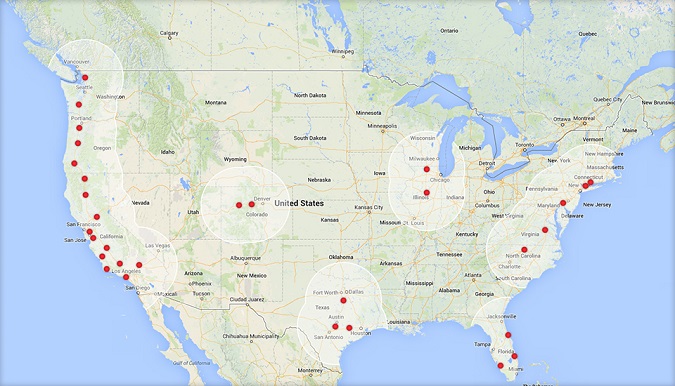Tesla Motors West Coast charging network now complete
Owners of the Tesla Motors electric Model S can now drive from San Diego to Vancouver without ever paying for juice.
Tesla has finished installing its high-speed Supercharger stations up the length of the West Coast, the Palo Alto company reported Tuesday. Model S drivers can use the stations for free, a welcome perk considering they’ve already shelled out $69,900 to $94,900 for the car.
Tesla has spaced the stations close enough to each other that Model S drivers won’t need to recharge anywhere else. And to demonstrate how well the system works, the company launched two Model S sedans from San Diego Wednesday morning, heading north on I5. The cars will stop at San Francisco’s Crissy Field at 9 a.m. Thursday for a brief reception. You can follow their progress on Twitter, via @TeslaMotors.
In addition, Tesla CEO Elon Musk tweeted Wednesday that the company’s East Coast network of Superchargers should be complete in “a few months.” Tesla plans to have its stations installed across the country by 2015. The stations are only compatible with the Model S. Even Tesla’s original car, the Roadster, can’t use them.
The company could use a little good news this week. Its high-flying stock has dropped about 6 percent after news surfaced of a second Model S catching fire, this time in Mexico. (Like the first fire, early this month, the new blaze wasn’t spontaneous — the driver hit two walls and slammed into a tree.) And Musk was quoted in the Financial Times saying the company’s valuation was higher than the company had “any right to deserve.” Tesla stock closed Wednesday at $159.22.
But the Supercharger’s West Coast milestone wasn’t Tesla’s only news of the day. The company also reported Wednesday that it had reached a new agreement with Panasonic Corp. to expand the number of battery cells that Panasonic will supply to Tesla. Over the next four years, Panasonic will deliver nearly 2 billion cells, enough for more than 285,000 cars. The Model S battery pack, capable of traveling 265 miles on a charge, contains 7,000 cells.

Tesla has finished installing its high-speed Supercharger stations up the length of the West Coast, the Palo Alto company reported Tuesday. Model S drivers can use the stations for free, a welcome perk considering they’ve already shelled out $69,900 to $94,900 for the car.
Tesla has spaced the stations close enough to each other that Model S drivers won’t need to recharge anywhere else. And to demonstrate how well the system works, the company launched two Model S sedans from San Diego Wednesday morning, heading north on I5. The cars will stop at San Francisco’s Crissy Field at 9 a.m. Thursday for a brief reception. You can follow their progress on Twitter, via @TeslaMotors.
In addition, Tesla CEO Elon Musk tweeted Wednesday that the company’s East Coast network of Superchargers should be complete in “a few months.” Tesla plans to have its stations installed across the country by 2015. The stations are only compatible with the Model S. Even Tesla’s original car, the Roadster, can’t use them.
The company could use a little good news this week. Its high-flying stock has dropped about 6 percent after news surfaced of a second Model S catching fire, this time in Mexico. (Like the first fire, early this month, the new blaze wasn’t spontaneous — the driver hit two walls and slammed into a tree.) And Musk was quoted in the Financial Times saying the company’s valuation was higher than the company had “any right to deserve.” Tesla stock closed Wednesday at $159.22.
But the Supercharger’s West Coast milestone wasn’t Tesla’s only news of the day. The company also reported Wednesday that it had reached a new agreement with Panasonic Corp. to expand the number of battery cells that Panasonic will supply to Tesla. Over the next four years, Panasonic will deliver nearly 2 billion cells, enough for more than 285,000 cars. The Model S battery pack, capable of traveling 265 miles on a charge, contains 7,000 cells.

You can return to the main Market News page, or press the Back button on your browser.

